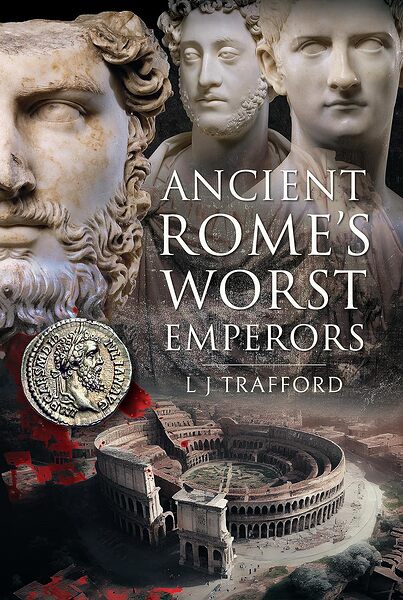Looking for a good read? Here is a recommendation. I have an unusual approach to reviewing books. I review books I feel merit a review. Each review is an opportunity to recommend a book. If I do not think a book is worth reading, I find another book to review. You do not have to agree with everything every author has written (I do not), but the fiction I review is entertaining (and often thought-provoking) and the non-fiction contain ideas worth reading.
Book Review
Why Not the Worst?
Reviewed by Mark Lardas
February 4, 2024
“Ancient Rome’s Worst Emperors,” by L J Trafford, Pen and Sword History, 2024, 216 pages, $34.95 (Hardcover), $12.99 (Ebook)
Eighty-four emperors ruled the Roman Empire between 27AD and 476AD. Some were very good, remembered as great leaders to the present day. Some were bad. A few were so bad they are even more famous (or perhaps infamous) than the good emperors.
“Ancient Rome’s Worst Emperors,” by L J Trafford focuses on the latter. It catalogs the worst of the worst. She picks out what she considers the dozen worst emperors and examines their careers in all their inglorious splendor. She spreads her choices throughout the life of the empire, four each from its beginning, middle, and end.
Her choices differ from the conventional list of worst emperors. Some of the usual suspect are present: Caligula, Domitian, Commodus, and Elagabalus. Others, like Nero and Tiberius are absent. A few of her choices are surprising. Galba, Nerva, Vitellius and Gordian I are generally acknowledged as less than stellar performers, but rarely make it to the bottom of the tank.
Trafford defends her choices. She makes them based on job performance rather than depravity. While a correlation exists between depravity and incompetence, some emperors of reputed immorality actually proved competent leaders. She cites Tiberius as an example. Additionally, she shows accusations of depravity were always post-mortem and frequently greatly exaggerated. (Although not necessarily much in the cases of Caligula and Elagabalus.) She reserves the worst emperor label for those emperors who left the empire much worse off for their existence.
She opens the book with a quick review of Roman government through the Republic into the opening years of the Empire. She also explains what an emperor was, the powers possessed by the emperor (especially at the outset of the Imperium), and how they were derived from the Republic. Then she shows what characteristics made a great emperor, using Augustus to illustrate her points. This section closes with a discussion of what constituted a bad emperor and why.
After that Trafford is off to the races, gleefully exposing the failures and follies of her dirty dozen emperors. She confesses to being bored with the well-run periods of the empire. The badly-times are more entertaining. While she revels in the scurrilous tales of emperors, she also debunks those accounts.
“Ancient Rome’s Worst Emperors,” reads like a supermarket tabloid, eagerly dishing dirt on the disfavored emperors. Yet it is solid history, irreverent, but accurate. Trafford has fun with her subject. So will her readers.
Mark Lardas, an engineer, freelance writer, historian, and model-maker, lives in League City. His website is marklardas.com.
